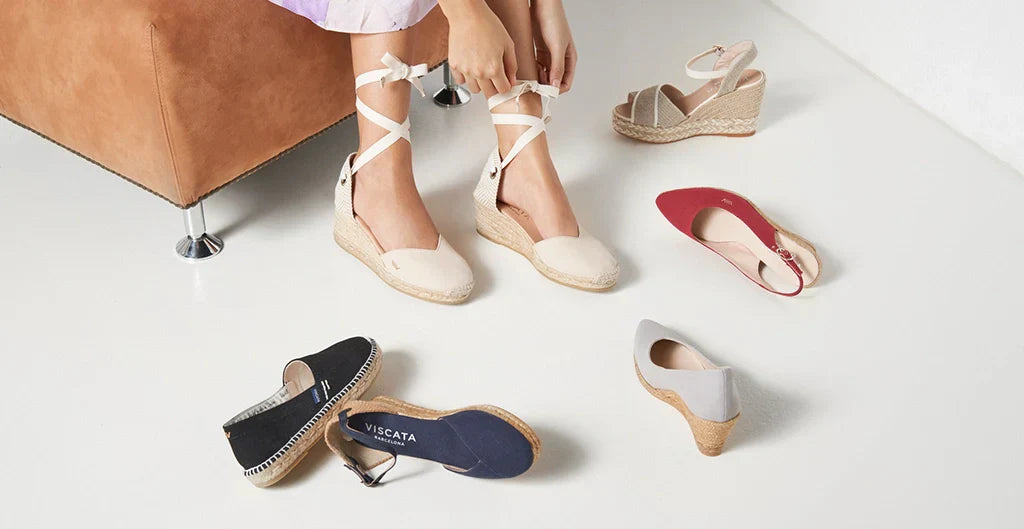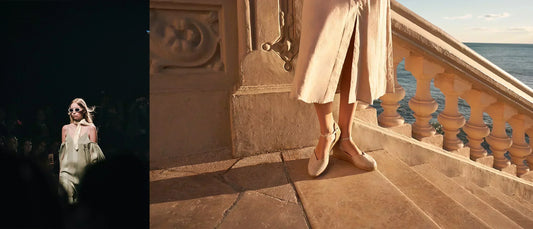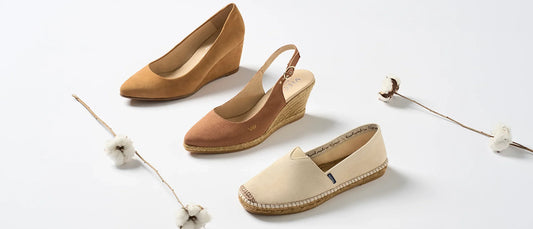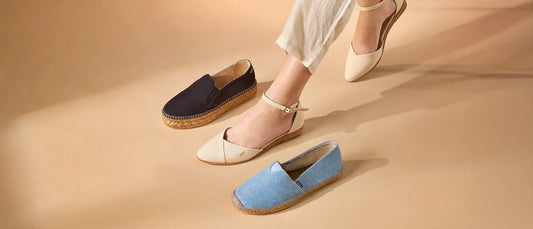
Espadrilles Origin: The History and Other Interesting Facts
What about a bit of history about our favorite type of shoe? Let's learn about the past of espadrilles and the etymology of the word.
What does "espadrilles" mean?
Espadrille in French or alpargatas in Spanish are footwear with a sole made of jute or fiber rope-like material from a plant. Espadrilles traditionally feature a fabric upper, often made from canvas or cotton, which contributes to their lightweight and breathable design.
The jute sole or rope sole is a defining characteristic of espadrilles, and these natural materials are key to their construction. The upper part of the shoe is typically made from natural materials such as cotton or canvas.
Espadrilles come in different styles, including flat, platform, wedge, high heeled, heels, and wedge heel designs. There are also modern versions with various heel heights, showcasing the versatility and adaptability of espadrilles to different styles.
Modern espadrilles may use rubber for the soles, but traditional espadrilles are known for their rope sole and natural materials.
Is "espadrilles" a Spanish word?
Espadrille is a French word that derives from the Occitan language espardenya or esparteña in Spanish. The Catalan word for espadrille is also 'espardenya', highlighting the regional linguistic roots of this traditional footwear. The words 'espadrille' and 'espadrilles' are used in different languages to describe this iconic type of shoe, which is characterized by its rope soles and fabric uppers.
Originally, espadrilles were crafted using esparto grass, a tough Mediterranean plant, and the primitive form of the shoe was simple, handmade, and authentic. In just a few words, this etymology conveys the deep history and tradition behind espadrilles. It refers to a type of shoe made of tough fiber used in making rope.
How do you pronounce "espadrilles"?
In English, the word espadrille is phonetically transcribed as it follows /espəˈdrɪl/ and the best way to nail its pronunciation is precisely by dividing the sounds into three syllables: [ESP] + [UH] + [DRIL]
Are espadrilles Spanish in origin?
Espadrilles originated in Spain. They were first discovered in the Occitania and Catalonia areas of the Pyrenees, on the Spanish and French borders. Espadrilles are also closely associated with the Basque region and Basque country, where basque espadrilles are a symbol of regional pride. Espadrilles were worn by both men and women, especially as traditional espadrilles for work, dance, and daily wear. Espadrilles were also the footwear for Catalonia’s traditional dance and they also had a contribution to Basque culture since the King of Aragon’s soldiers wore them too. Espadrilles were worn by Catalan rebels during the Spanish Civil War, highlighting their practical and cultural significance.
Traditional espadrilles feature rope soles made from ropes such as jute or hemp, and laces are often used to tie them around the ankle. Espadrilles are considered comfortable footwear, ideal as a summer shoe for the summer months, and are known for their casual style and versatility as versatile shoes. They have a rich history as durable, fashionable footwear, and espadrilles produced in Spain and France are valued for their craftsmanship. Espadrilles can be made with leather or hemp uppers, and their design is inspired by traditional sandals.
Who invented espadrilles?
The first espadrille was recorded from the Occitania region in France in the 13th century. Espadrilles dates back to the 14th century, with some sources tracing their origins to the 13th and 14th centuries. Century espadrilles have evolved over time, with significant developments in the 20th century, including their adoption by famous women and celebrities.
Espadrilles became especially popular in northern France among mining workers, and were later exported to South America, where they became a staple summer shoe. It was later popularized by French fashion designer Yves Saint Laurent who was looking for a new design of wedge and his vision became an instant hit even today. Yves Saint Laurent introduced the wedge espadrille and heeled espadrilles, creating modern versions and different styles that became fashionable among women. Wedge espadrilles and heeled espadrilles are now iconic styles, and the modern espadrille is available in a variety of styles. Style icons such as Grace Kelly, Lauren Bacall, and Rita Hayworth helped popularize espadrilles in the 20th century. Espadrilles are especially popular among women, and their popularity surges each spring as a fashionable summer shoe.
Who sells espadrilles?
Espadrilles are usually handcrafted by high skilled artisans in countries like Spain but nowadays they are sold almost everywhere in the world. Today, they’re available worldwide, offered by both affordable retailers and luxury brands. At Viscata, we proudly sell an amazing selection of handcrafted women’s and men’s espadrilles. Explore our espadrilles collection to find your new perfect pair!


